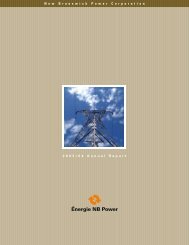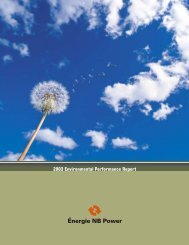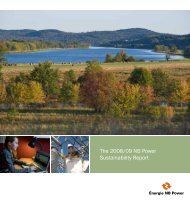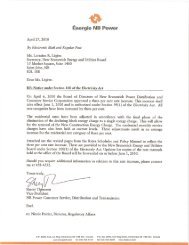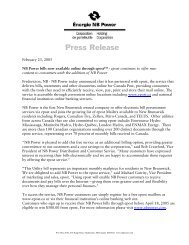Environmental Impact Assessment(EIA) Registration for the ...
Environmental Impact Assessment(EIA) Registration for the ...
Environmental Impact Assessment(EIA) Registration for the ...
You also want an ePaper? Increase the reach of your titles
YUMPU automatically turns print PDFs into web optimized ePapers that Google loves.
REVISED PROJECT DESCRIPTION AND ENVIRONMENTAL IMPACT ASSESSMENT (<strong>EIA</strong>) REGISTRATION<br />
FOR THE NEPISIGUIT FALLS GENERATING STATION MODIFICATION AND REHABILITATION PROJECT<br />
The Canada Lynx (Lynx canadensis – S1), is listed as “regionally endangered” under <strong>the</strong><br />
NB ESA. Lynx are secretive woodland cats that rely on snowshoe hare populations. The<br />
observation of Canada Lynx from AC CDC report was made approximately 4 km northwest of<br />
<strong>the</strong> PDA.<br />
The AC CDC report also recorded <strong>the</strong> potential <strong>for</strong> Wood Turtle (Glyptemys insculpta) within a<br />
5 km radius of <strong>the</strong> Project. Wood Turtle is listed as Special Concern by SARA and Threatened<br />
in NBDNR General Status Ranks. Wood Turtle are considered a semi-aquatic species, and<br />
prefer riparian areas with patchy cover, and clear meandering watercourses with gravely-sandy<br />
substrate and banks.<br />
Typical assemblages of wildlife are anticipated to be present proximate to <strong>the</strong> PDA, including<br />
moose (Alces alces), white-tailed deer (Odocoileus virginianus), American black bear (Ursus<br />
americanus), fox (Vulpes vulpes), American mink (Mustela vison), beaver (Castor canadensis),<br />
striped skunk (Mephitis mephitis), porcupine (Erethizon dorsatum), raccoon (Procyon lotor), and<br />
varying hare (Lepus americanus). Small mammals such as red squirrel (Tamiasciurus<br />
hudsonicus), voles, shrews and mice are anticipated to be common and widespread.<br />
No Important Bird Areas (IBAs) are located within <strong>the</strong> LAA of <strong>the</strong> Project. The closest IBAs to<br />
<strong>the</strong> PDA are <strong>the</strong> Nepisiguit Highlands (NB024) and <strong>the</strong> Tabusintac Lagoon and River Estuary<br />
(NB002) which are located approximately 60 km west, and 75 km east of <strong>the</strong> Project,<br />
respectively.<br />
No locations of critical or sensitive habitat <strong>for</strong> wildlife are known within <strong>the</strong> 5 km radius of <strong>the</strong><br />
NFGS.<br />
3.5.2 Rare Plants<br />
The AC CDC report included one rare or uncommon vascular plant species that was observed<br />
within a 5 km radius of <strong>the</strong> PDA. Drummond’s rockcress (arabis drummondii – S2) was<br />
recorded approximately 1 km downstream of Nepisiguit Falls, along <strong>the</strong> Nepisiguit River. The<br />
usual habitat <strong>for</strong> this species is dry to moist calcareous soils, along dry ledges or sandy and<br />
rocky riverbanks where little over-shading would occur.<br />
Three o<strong>the</strong>r rare or uncommon plant species that were reported by AC CDC as possibly located<br />
within a 5 km radius of <strong>the</strong> PDA, although no specific occurrences have been noted. These<br />
species include: Sou<strong>the</strong>rn twayblade (Listera australis – provincially Endangered), Prototype<br />
Quillwort (Isoetes prototypes – provincially Endangered) and Giant pinedrops (Pterospora<br />
andromedea – no provincial or COSEWIC/SARA ranking).<br />
Sou<strong>the</strong>rn twayblade is typically found in peat bog habitat, among mosses. This species grows<br />
above <strong>the</strong> water level, also on <strong>the</strong> fen floor and on <strong>the</strong> sides of hummocks around trees where<br />
very little competing shrub cover would be found.<br />
June 15, 2011 Page 29




